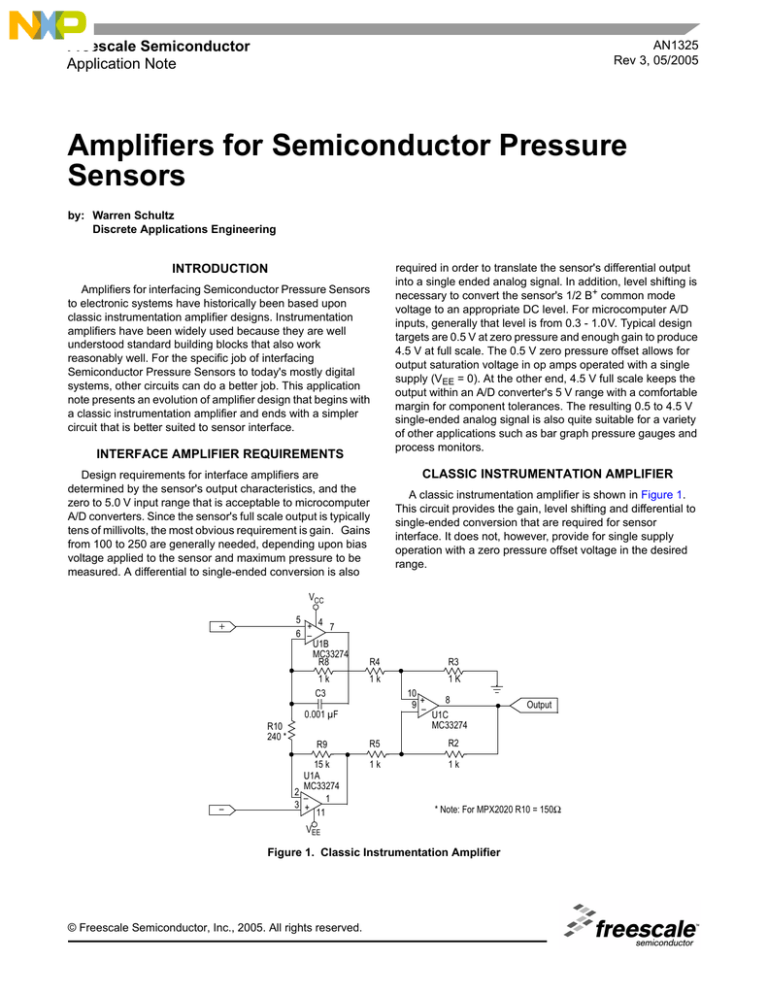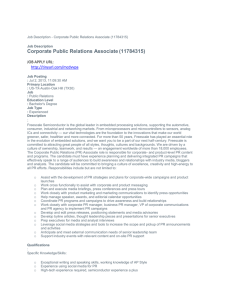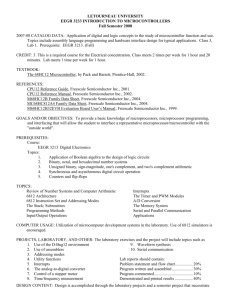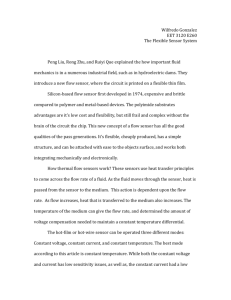
Freescale Semiconductor
Application Note
AN1325
Rev 3, 05/2005
Amplifiers for Semiconductor Pressure
Sensors
by: Warren Schultz
Discrete Applications Engineering
INTRODUCTION
Amplifiers for interfacing Semiconductor Pressure Sensors
to electronic systems have historically been based upon
classic instrumentation amplifier designs. Instrumentation
amplifiers have been widely used because they are well
understood standard building blocks that also work
reasonably well. For the specific job of interfacing
Semiconductor Pressure Sensors to today's mostly digital
systems, other circuits can do a better job. This application
note presents an evolution of amplifier design that begins with
a classic instrumentation amplifier and ends with a simpler
circuit that is better suited to sensor interface.
INTERFACE AMPLIFIER REQUIREMENTS
Design requirements for interface amplifiers are
determined by the sensor's output characteristics, and the
zero to 5.0 V input range that is acceptable to microcomputer
A/D converters. Since the sensor's full scale output is typically
tens of millivolts, the most obvious requirement is gain. Gains
from 100 to 250 are generally needed, depending upon bias
voltage applied to the sensor and maximum pressure to be
measured. A differential to single-ended conversion is also
required in order to translate the sensor's differential output
into a single ended analog signal. In addition, level shifting is
necessary to convert the sensor's 1/2 B+ common mode
voltage to an appropriate DC level. For microcomputer A/D
inputs, generally that level is from 0.3 - 1.0V. Typical design
targets are 0.5 V at zero pressure and enough gain to produce
4.5 V at full scale. The 0.5 V zero pressure offset allows for
output saturation voltage in op amps operated with a single
supply (VEE = 0). At the other end, 4.5 V full scale keeps the
output within an A/D converter's 5 V range with a comfortable
margin for component tolerances. The resulting 0.5 to 4.5 V
single-ended analog signal is also quite suitable for a variety
of other applications such as bar graph pressure gauges and
process monitors.
CLASSIC INSTRUMENTATION AMPLIFIER
A classic instrumentation amplifier is shown in Figure 1.
This circuit provides the gain, level shifting and differential to
single-ended conversion that are required for sensor
interface. It does not, however, provide for single supply
operation with a zero pressure offset voltage in the desired
range.
VCC
5
+ 4 7
6 –
U1B
MC33274
R8
+
1k
C3
1k
–
R9
15 k
U1A
MC33274
2
–
1
3 +
11
1K
10
9 +–
0.001 µF
R10
240 *
R3
R4
8
U1C
MC33274
R5
R2
1k
1k
* Note: For MPX2020 R10 = 150Ω
VEE
Figure 1. Classic Instrumentation Amplifier
© Freescale Semiconductor, Inc., 2005. All rights reserved.
Output
B+
U2
MC78L08ACP
3
I
G
2
O
1
C2
0.1 µF
C1
1 µF
Zero
5
+ 4 7
6
- U1B
MC33274
R8
15 k
GND
3
2
XDCR1
MPX2000 Series
Pressure Sensor
4
1
C3
R10 0.001 µF
240*
R9
15 k
U1A
2 MC33274
1
3
+ 11
R7
7.5 k
R6
1k
12
+
13 -
14
U1D
MC33274
R4
R31
1k
1k
U1C
10 MC33274
+
8
9
-
R5
R2
1k
1k
Output
* Note: For MPX2010 R10 = 150 Ω
Figure 2. Instrumentation Amplifier Interface
To provide the desired DC offset, a slight modification is
made in Figure 2. R3 is connected to pin 14 of U1D, which
supplies a buffered offset voltage that is derived from the
wiper of R6. This voltage establishes a DC output for zero
differential input. The translation is one to one. Whatever
voltage appears at the wiper of R6 will, within component
tolerances, appear as the zero pressure DC offset voltage at
the output.
With R10 at 240 Ω gain is set for a nominal value of 125,
providing a 4.0 V span for 32 mV of full scale sensor output.
Setting the offset voltage to 0.75 V, results in a 0.75 V to 4.75
V output that is directly compatible with microprocessor A/D
inputs.
This circuit works reasonably well, but has several notable
limitations when made with discrete components. First, it has
a relatively large number of resistors that have to be well
matched. Failure to match these resistors degrades common
mode rejection and initial tolerance on zero pressure offset
voltage. It also has two amplifiers in one gain loop, which
makes stability more of an issue than it is in the following two
alternatives. This circuit also has more of a limitation on zero
pressure offset voltage than the other two. The minimum
output voltage of U1D restricts the minimum zero pressure
offset voltage that can be accommodated, given component
tolerances. The result is a 0.75 V zero pressure offset voltage,
compared to 0.5 V for each of the following two circuits.
SENSOR SPECIFIC AMPLIFIER
The limitations associated with classic instrumentation
amplifiers suggest that alternate approaches to sensor
interface design are worth looking at. One such approach is
shown in Figure 3. It uses one quad op amp and several
resistors to amplify and level shift the sensor's output.
Most of the amplification is done in U1A, which is
configured as a differential amplifier. It is isolated from the
sensor's minus output by U1B. The purpose of U1B is to
prevent feedback current that flows through R5 and R6 from
flowing into the sensor. At zero pressure the voltage from pin
2 to pin 4 on the sensor is zero V. For example, assume that
the common mode voltage is 4.0 V. The zero pressure output
voltage at pin 1 of U1A is then 4.0 V, since any other voltage
would be coupled back to pin 2 via R6 and create a non zero
bias across U1A’s differential inputs. This 4.0 V zero pressure
DC output voltage is then level translated to the desired zero
pressure offset voltage by U1C and U1D. To see how the level
translation works, assume the wiper of R9 is at ground. With
4.0 V at pin 12, pin 13 is also at 4.0 V. This leaves 4.0 V across
(R3 + R9), which total essentially 1.0 kΩ. Since no current
flows through R4, producing approximately 4.0 V across R4,
as well. Adding the voltages (4.0 + 4.0) yields 8.0 V at pin 14.
Similarly, 4.0 V at pin 10 implies 4.0 V at pin 9, and the drop
across R2 is 8.0 V –4.0 = 4.0 V. Again 4.0 V across R2 implies
an equal drop across R1, and the voltage at pin 8 is 4.0 V –
4.0 V. In practice, the output of U1C will not go all the way to
AN1325
2
Sensors
Freescale Semiconductor
ground, and the voltage injected by R8 at the wiper of R9 is
approximately translated into a DC offset.
Gain is approximately equal to R6/R5(R1/R2+1), which
predicts 125 for the values shown in Figure 3. A more exact
calculation can be performed by doing a nodal analysis, which
yields 127. Cascading the gains of U1A and U1C using
standard op amp gain equations does not give an exact result,
because the sensor's negative going differential signal at pin
4 subtracts from the DC level that is amplified by U1C. Setting
offset to 0.5 V results in an analog zero to full scale range of
0.5 to 4.5 V. For this DC output voltage to be independent of
the sensor's common mode voltage it is necessary to satisfy
the condition that R1/R2 = (R3+R9)/R4.
B+
U2
3 MP78L08ACP
I
1
G
O
2
C1
1 µF
TP2 + 8.0 V
C2
0.1 •F
3
+ 4 1
2 –
U1A
MC33274
R6
XDCR1
MPX2000 Series
Pressure Sensor
3
2
U1C
MC33274
+
8
9 –
R1
10
7.5 k
R5
120*
GND
R8
1.5 k
R8
4
1
2k
R2
U1B
MC33274
6
–
7
5 +
11
200
Zero
Cal.
Out
R3
2k
+
14
13 –
U1D
MC33274
R4
820
1k
12
* Note: For MPX2010 R5 = 75Ω
Figure 3. Sensor Specific Amplifier
This approach to interface amplifier design is an
improvement over the classic instrument amplifier in that it
uses fewer resistors, is inherently more stable, and provides a
zero pressure output voltage that can be targeted at 0.5 V. It
has the same tolerance problem from matching discrete
resistors that is associated with classic instrument amplifiers.
SENSOR MINI AMP
Further improvements can be made with the circuit that is
shown in Figure 4. It uses one dual op amp and several
resistors to amplify and level shift the sensor's output. To see
how this amplifier works, let's simplify it by grounding the
output of voltage divider R3, R5 and assuming that the divider
impedance is added to R6, such that R6 = 12.4 k. If the
common mode voltage at pins 2 and 4 of the sensor is 4.0 V,
then pin 2 of U2A and pin 6 of U2B are also at 4.0 V. This puts
4.0 V across R6, producing 323 µA. Assuming that the current
in R4 is equal to the current in R6, 323 µA • 100 Ω produces
a 32 mV drop across R4 which adds to the 4.0 V at pin 2. The
output voltage at pin 1 of U2A is, therefore, 4.032 V. This puts
4.032 - 4.0 V across R2, producing 43 µA. The same current
flowing through R1 again produces a voltage drop of 4.0 V,
which sets the output at zero. Substituting a divider output
greater than zero into this calculation reveals that the zero
pressure output voltage is equal to the output voltage of
divider R3, R5. For this DC output voltage to be independent
of the sensor's common mode voltage it is necessary to satisfy
the condition that R1/R2 = R6/R4, where R6 includes the
divider impedance.
Gain can be determined by assuming a differential output
at the sensor and going through the same calculation. To do
this assume 100 mV of differential output, which puts pin 2 of
U2A at 3.95 V, and pin 6 of U2B at 4.05 V. Therefore, 3.95 V
is applied to R6, generating 319 µA. This current flowing
through R4 produces 31.9 mV, placing pin 1 of U2A at 3950
mV + 31.9 mV = 3982 mV. The voltage across R2 is then
4050 mV - 3982 mV = 68 mV, which produces a current of
91µA that flows into R1. The output voltage is then 4.05 V +
(91 µA • 93.1 k) = 12.5 V. Dividing 12.5 V by the 100 mV input
yields a gain of 125, which provides a 4 V span for 32 mV of
full scale sensor output. Setting divider R3, R5 at 0.5 V results
in a 0.5 V to 4.5 V output that is comparable to the other two
circuits.
This circuit performs the same function as the other two
with significantly fewer components and lower cost. In most
cases it is the optimum choice for a low cost interface
amplifier.
AN1325
Sensors
Freescale Semiconductor
3
B+
C1
0.2 µF
U1
3 MC78L08ACP
I
1
O
G
C2
2
0.2 µF
5
–
6 +
3
4
2
XDCR1
MPX2000 Series
Sensor
R1 93.1 k 1%
C2 0.001 µF
GND
R5
1.33 k
1%
Out
U2B
MC33272
1
R3
39.2 k
1%
R7
TRIM
8 7
R6
11 k
1%
U1B
3 MC33272
+
1
2 –
4
R2
750
1%
R4
100
1%
Notes: R7 is nominally 39.2 k and selected for zero pressure VOUT = 0.5 V
for MPX2010 Sensors R1 = 150 k and R4 = 61.9 Ω
Figure 4. Sensor Mini Amp
Performance differences between the three topologies are
minor. Accuracy is much more dependent upon the quality of
the resistors and amplifiers that are used and less dependent
on which of the three circuits are chosen. For example, input
offset voltage error is essentially the same for all three circuits.
To a first order approximation, it is equal to total gain times the
difference in offset between the two amplifiers that are directly
tied to the sensor. Errors due to resistor tolerances are
somewhat dependent upon circuit topology. However, they
are much more dependent upon the choice of resistors.
Choosing one percent resistors rather than five percent
resistors has a much larger impact on performance than the
minor differences that result from circuit topology. Assuming a
zero pressure offset adjustment, any of these circuits with an
MPX2000 series sensor, one percent resistors and an
MC33274 amplifier results in a ±5% pressure to voltage
translation from 0 to 50°C. Software calibration can
significantly improve these numbers and eliminate the need
for analog trim.
CONCLUSION
Although the classic instrumentation amplifier is the best
known and most frequently used sensor interface amplifier, it
is generally not the optimal choice for inexpensive circuits
made from discrete components. The circuit that is shown in
Figure 4 performs the same interface function with
significantly fewer components, less board space and at a
lower cost. It is generally the preferred interface topology for
MPX2000 series semiconductor pressure sensors.
AN1325
4
Sensors
Freescale Semiconductor
NOTES
AN1325
Sensors
Freescale Semiconductor
5
NOTES
AN1325
6
Sensors
Freescale Semiconductor
NOTES
AN1325
Sensors
Freescale Semiconductor
7
How to Reach Us:
Home Page:
www.freescale.com
E-mail:
support@freescale.com
USA/Europe or Locations Not Listed:
Freescale Semiconductor
Technical Information Center, CH370
1300 N. Alma School Road
Chandler, Arizona 85224
+1-800-521-6274 or +1-480-768-2130
support@freescale.com
Europe, Middle East, and Africa:
Freescale Halbleiter Deutschland GmbH
Technical Information Center
Schatzbogen 7
81829 Muenchen, Germany
+44 1296 380 456 (English)
+46 8 52200080 (English)
+49 89 92103 559 (German)
+33 1 69 35 48 48 (French)
support@freescale.com
Japan:
Freescale Semiconductor Japan Ltd.
Headquarters
ARCO Tower 15F
1-8-1, Shimo-Meguro, Meguro-ku,
Tokyo 153-0064
Japan
0120 191014 or +81 3 5437 9125
support.japan@freescale.com
Asia/Pacific:
Freescale Semiconductor Hong Kong Ltd.
Technical Information Center
2 Dai King Street
Tai Po Industrial Estate
Tai Po, N.T., Hong Kong
+800 2666 8080
support.asia@freescale.com
For Literature Requests Only:
Freescale Semiconductor Literature Distribution Center
P.O. Box 5405
Denver, Colorado 80217
1-800-441-2447 or 303-675-2140
Fax: 303-675-2150
LDCForFreescaleSemiconductor@hibbertgroup.com
AN1325
Rev. 3
05/2005
Information in this document is provided solely to enable system and software
implementers to use Freescale Semiconductor products. There are no express or
implied copyright licenses granted hereunder to design or fabricate any integrated
circuits or integrated circuits based on the information in this document.
Freescale Semiconductor reserves the right to make changes without further notice to
any products herein. Freescale Semiconductor makes no warranty, representation or
guarantee regarding the suitability of its products for any particular purpose, nor does
Freescale Semiconductor assume any liability arising out of the application or use of any
product or circuit, and specifically disclaims any and all liability, including without
limitation consequential or incidental damages. “Typical” parameters that may be
provided in Freescale Semiconductor data sheets and/or specifications can and do vary
in different applications and actual performance may vary over time. All operating
parameters, including “Typicals”, must be validated for each customer application by
customer’s technical experts. Freescale Semiconductor does not convey any license
under its patent rights nor the rights of others. Freescale Semiconductor products are
not designed, intended, or authorized for use as components in systems intended for
surgical implant into the body, or other applications intended to support or sustain life,
or for any other application in which the failure of the Freescale Semiconductor product
could create a situation where personal injury or death may occur. Should Buyer
purchase or use Freescale Semiconductor products for any such unintended or
unauthorized application, Buyer shall indemnify and hold Freescale Semiconductor and
its officers, employees, subsidiaries, affiliates, and distributors harmless against all
claims, costs, damages, and expenses, and reasonable attorney fees arising out of,
directly or indirectly, any claim of personal injury or death associated with such
unintended or unauthorized use, even if such claim alleges that Freescale
Semiconductor was negligent regarding the design or manufacture of the part.
Freescale™ and the Freescale logo are trademarks of Freescale Semiconductor, Inc.
All other product or service names are the property of their respective owners.
© Freescale Semiconductor, Inc. 2005. All rights reserved.




